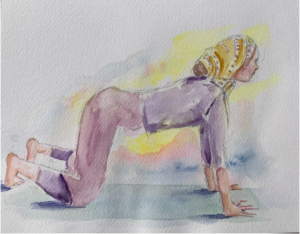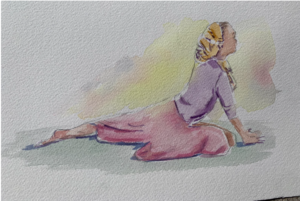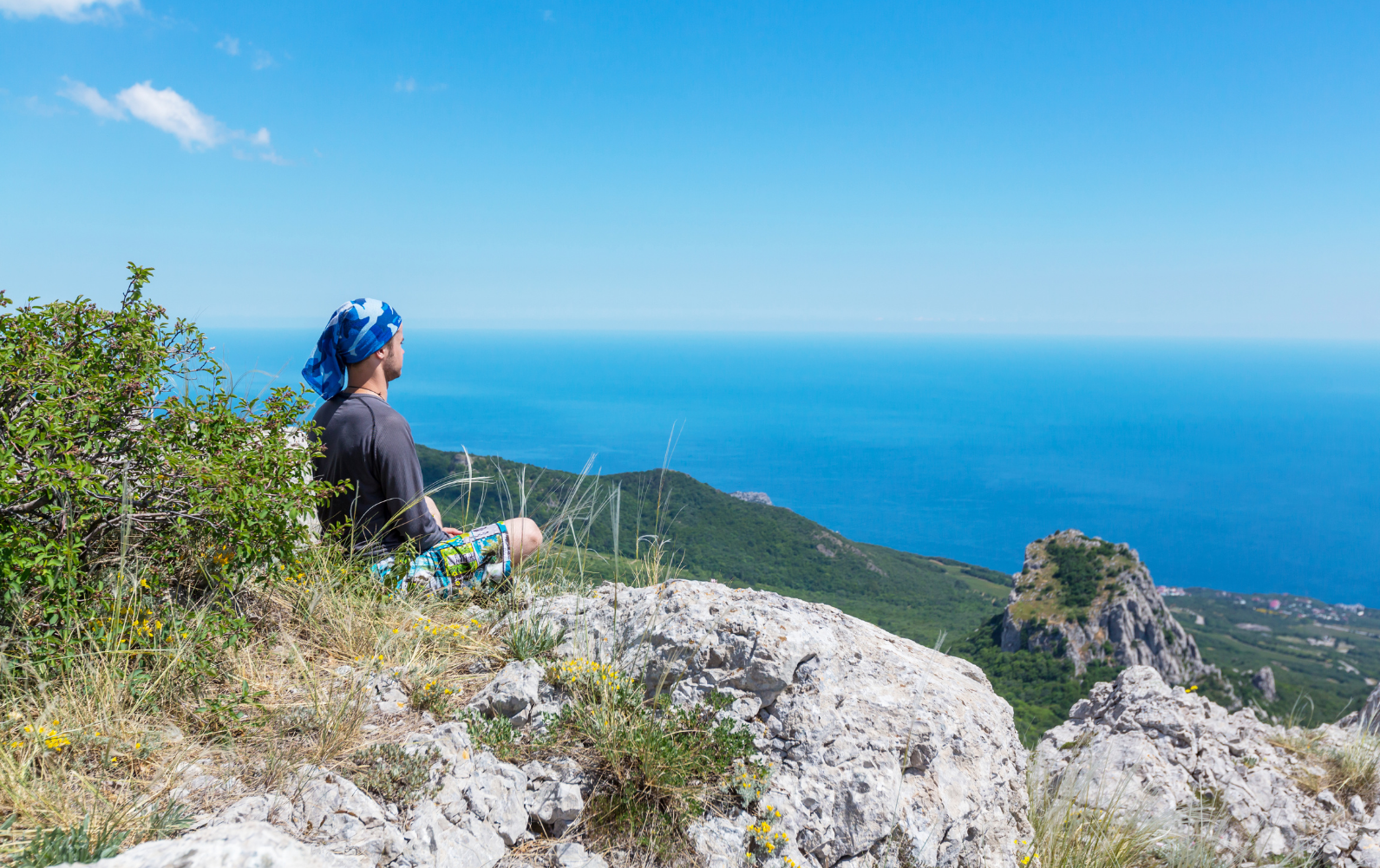We welcome this new month in the spirit and in the body, with our guest – Jenna Zadaka, MA: CCC-SLP, RYT, who blends ancient Jewish wisdom with mindfulness and yoga sequences. Jenna brings us Jewish teachings about this new month, mapped alongside yoga postures to embody the teachings, illustrated in gorgeous water colour paintings.
Enter your Ark
In Cheshvan( חֶשְׁוַן), we leave the warm, extroverted summer months and begin to retreat inwards. Cheshvan is known as, “Mar (Bitter) Cheshvan” because of the lack of holidays and energy channels to connect to. This month could feel like we are spiritually falling from the last month, Tishrei, which was filled with jewish holidays and a downward flow of energy. However, we are not falling; we are deepening to rise. We are not descending, but rather rooting inwards. This month calls us to celebrate life differently. While there is a lack of warmth, social extroversion, and holidays, this month calls us to celebrate life differently.Cheshvan invites us to retreat, reflect, and replenish.
This is why in Cheshvan, Noah entered the Ark (Teivah) during the great flood (Bereishit 7:11, Rosh Hashana 10b). When winter comes in, we hibernate and retreat into our personal arks, protected from the elements. The hebrew name ‘Noah’ is closely related to the hebrew word, ‘rest’. Chassidic commentaries explain that Noah’s experience in the ark reflected the reality of Shabbat. Just like the ark protected Noah from the turbulent waves of the flood, Shabbat provides a refuge from the chaotic business of the workweek.
By retreating, we can integrate and digest all that we experienced in Tishrei. We can start to explore the energetics of the inner world. This may be why in Sefer Yetzirah, the body part connected to Cheshvan is the ‘Dakin’, or ‘intestines’. Just like the intestines digest and break down nutrients, we are called upon to break down, absorb, and integrate all that we received during our spiritual times of abundance. According to Rav Dovber Pinson, “..the function of the ‘Dakin’ is to transform material substances into spirit/energy, as part of the progressive refinement of the material world.(The Month of Cheshvan, p.87). Just like the work of the intestines, our work of the month is to tap into the deep places within ourselves and produce our own energy to warm us through the winter. When there is no external inspiration to lift us up, it is a precious time to self-generate, find our own internal heat, and tap into our inner wellsprings of energy and creativity.
Yoga is an elixir to tap into this retreat mode. As we unroll our mats, we carve out space and time to connect inwards and generate our own heat, away from the noise of the world.
Posture 1: Bound Angle

Start in a seated position and touch the soles of the feet together, dropping the knees out to side in a diamond shape. Anchor your pelvic floor to the earth beneath you. Walk your fingertips in front of you and fold forward, drawing the gaze inwards. Loosen the jaw line and soften the muscles of the face. The sacrum widens in the low back, as the shoulders drape forward. Here, we enter into our inner ark of retreat and restore. What does it feel like to be in this body, right here and now?
Posture 2: Cat & Cow Variation:

Come down onto your hands and knees, aligning your wrists directly under the shoulders and the hips above the knees. Instead of traditional cat and cow, invite the element of water into your movements by swaying or circling the hips and finding your own fluid adjustments to lubricate the joints and enter into the juice of the hips.
Posture 3: Pigeon Pose:

From a neutral cat & cow stance, send the right knee across the body to touch the right wrist on the floor. Your left leg softly melts towards the ground. Square your hips towards the front of the mat. Soften the shoulders and breathe deeply into your hips. This pose is both a perfect hip opener and a restorative posture that allows emotional waves to roll in and out. Like water, we receive all the sensations with the acceptance of impermanence.
And now, we will elaborate on the wisdom of the month, with associated practices:
Cheshvan’s Element: Water
The element connected with the month of Cheshvan is water. Cheshvan is when the autumn rain begins to fall in the holy land (Ta’anis 5a), when the Mabul (great flood) began, and the first signal of winter. Water in Judaism facilitates transition. The Jews left slavery behind by walking through the Sea of Reeds. A mikvah is a body of rainwater that transforms someone in processes of purity, conversion and marriage. Just like a mikvah has 40 Se’ah of water to be considered Kosher, the flood cast on Noah’s generation cleansed the world for 40 days. The Mabul was like a vast mikvah to the land, purifying the world to a new potential. With no holidays or peak experiences in Cheshvan, we are called to find our inner reservoirs and wellsprings.
Practice:
Water is the element of equanimity and impermanence. Water moves fluidly and yields to obstructions, yet it has the power to carve out canyons! Just like water ebbs and flows, we practice acceptance through all of the changes in our life, both external and internal. We continually ask ourselves, do I know when to surrender? Do I know how to retreat? The lesson of water is to know how to trust the innate flow of life, how to yield instead of resist.
In the body, the water element is seated in the hips and pelvis. We can connect to this element through fluid, curved, creative movements. Instead of hard stops between poses, liquify your yoga practice by gently breathing and moving with intentional transitions from one pose to the next. Many people, especially women, store their anxieties and stress in their hips. Engaging, opening and deepening through the hips can be a healing way of releasing tension and stress. We invite cool fluid waves through the body. For additional water healing, you can practice by a body of water, play soothing ocean sounds, or activate your Ujayii ocean breath.
Cheshvan’s Sense: Smell
Cheshvan corresponds to the Chush (sense) of smell. Rav Ginsburgh points out that the word for smell in hebrew, Re’ach, has the same letters as the word for spirit, ‘Ru’ah’. Our tradition teaches that the garden of Eden had a beautiful fragrance. The only sense that wasn’t involved in the story of eating from the tree in the garden of Eden, was the sense of smell/scent. While hearing (the snake), seeing (the fruit), touching and tasting it were part of the unaligned action of Adam and Chavah, the sense of smell remained pure, and continues to remain pure to this day. Our olfactory ability relates back to the radiant state of Adam and Chavah when their body and soul were perfectly unified.
Avraham Sand, in his book “Mystical Aromatherapy: The Divine Gift of Fragrance,” explains many kabbalastic, midrashic, and Talmudic texts around fragrance. He speaks about the “Scent of Paradise” emanating from the Garden of Eden. The garments that G-d gave to Adam and Chavah in the Garden of Eden were saturated with the heavenly fragrance of Eden. Kabbalah explains that the garment was engraved with designs of animals, mystical symbols, and imbued with the beautiful Gan Eden fragrance. This garment was passed down through the generations. Adam and Chavah gave it to their son, Seth, who passed it down to Noah (which was brought into the ark), to Abraham, to Isaac, to Jacob (known as the, ‘coat of many colors’), and to Moses. The Talmud explains that when Moses ascended to Mt. Sinai to receive the Torah, the “world was filled with fragrance”, referring to the fragrance of paradise (Gemara Shabbat, 88b). And in the future, redemptive times, Moshiach will judge by his sense of smell (Isaiah 11:3; Sanhedrin 93b).
The Talmud relates that smell is the primary vehicle that connects to our super-consciousness, known as the ‘Ruach HaKodesh”, or “holy spirit” (Brachot: 43b). Biologically, all of our senses path through complex networks that are encoded in the rational brain/cortical memory center, known as the hippocampus. Smell, on the other hand, has a direct pathway to the limbic brain, the cerebral area associated with intuition and dreams. The limbic system is associated with spiritual and mystical experiences. Smell has the ability to bring us healing, as it is a reliable chamber to the aromatic medicines we need. It also transports us back in time by triggering vivid memories. Patrician Davis, a master aromatherapist, tells us that, “the (limbic) area of the brain that registers smell is very closely connected to the area which is involved with memory, and both are situated in the “oldest” part of our brain…the part that was already developed in our most primitive ancestors.” Smell carries us back to our past, across vast spans of times, all the way to Gan Eden.
Practice:
To activate this pristine sense of smell, start your yoga practice by lighting scented candles, brewing some herbal tea, or dabbing a few drops of pure essential oils onto the corners of your mat or onto your temples and wrists. When choosing essential oils, you can use Avraham Sand’s method and intuitively choose the oil that you are drawn to. Take a deep inhale through your nose, and notice the effects the essential oil has on your mind and body. Or, you can choose an oil based on a physical or psychological need. Some suggestions are:
Cedarwood: A woodsy scent that is used for skin & scalp care, is helpful for a relaxing nighttime routine, and used as an antiseptic
Clary Sage: An herbaceous fragrance with deeply calming effects, alleviates menstrual cramps and menopausal symptoms, and treats minor wounds
Eucalyptus: A Fresh, clean fragrance to uplift moods, can be used as a cold & flu remedy, and treats sore muscles
Frankincense: An earthy aroma that stimulates the brain’s emotional center, soothes the mind, and promotes healing for respiratory system defects and stomach ailments
Geranium: A beautiful floral aroma with a hint of mint to balance the emotions and hormones, stimulates the lymph system, can be used as a natural insect repellent, and improves the skin
Jasmine: A sweet smell that alleviates depression and eases menstrual complaints
Lavender: The most versatile of oils to treat an array of ailments and balance the emotions.
To conclude today’s learning and yoga practice – focus your breathwork on inhaling in and out through the nose and into the belly. This will help calm your nervous system, and maximum the full benefits of your breath. Nasal breathing stimulates the olfactory nerve, which is often associated with the “third eye” of inner wisdom. Breathing through the nose also ensures you take deep, full breaths to distribute greater amounts of oxygen throughout the body, and balance the body’s energy channels, and the two hemispheres of the brain, revitalizes you, reduces stress, and promote healthy blood circulation.
That sums up the month of Cheshvan! Thanks for joining this new moon and new month together, with The Art of Living Jewishly. Chodesh Tov!
Jenna Zadaka can be reached at www.breathandsoul.net, or on instagram @jennazadaka, where she shares wisdom and teaches yoga.


0 Comments